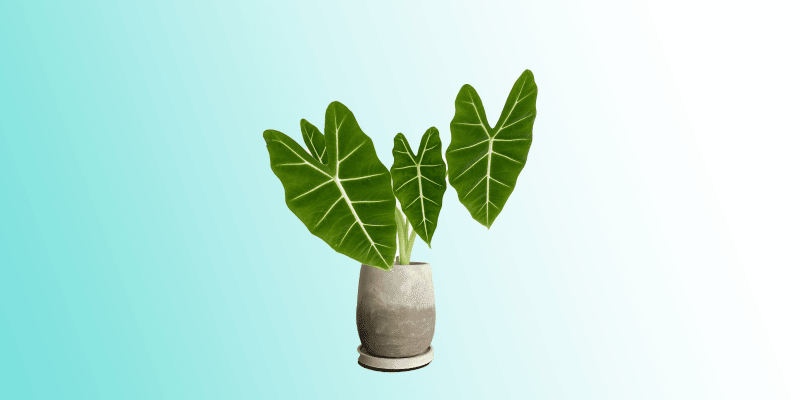One of the most richly colored varieties of elephant ear, Alocasia frydek has leaves with such lush, dark greens that they look nearly back. They’re huge, too, like elephant ears—perfect for adding elephantine (ahem, ahem) intrigue to any room.
Caring for this plant isn’t exactly set it and forget it, but it also isn’t difficult, either. We’ll explore how to take care of your Alocasia frydek, take a quick journey into its discovery, and cover how to deal with the most common issues with care and propagation.
Table of Contents
Alocasia Frydek Care Guide
History, habitat, and characteristics
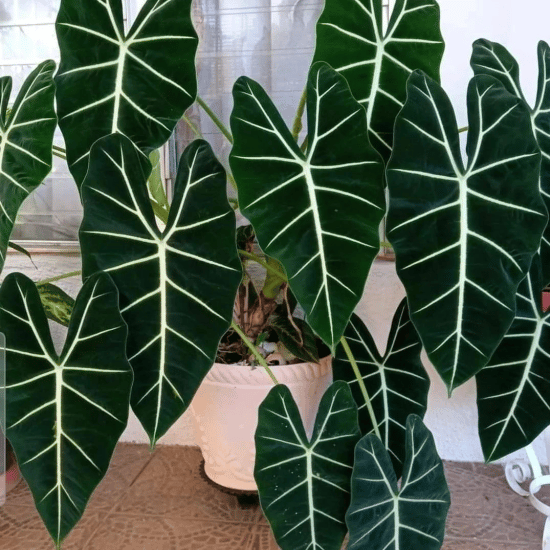
Small note: Alocasia frydek is actually a variegated cultivar (later, different version) of Alocasia micholitziana. However, it’s become known in popular plant culture as the original, so for the purposes of this article, we’ll refer to it as such.
A variety of Elephant ear from southeast Asia, specifically the Philippines, Alocasia frydek was first described in 1912 and named after Wilhelm Micholitz, a German plant collector. From the Araceae family, the alocasia genus is rhizomatous, which means it has an underground horizontal root system. Its rhizome stores proteins and carbohydrates to sustain it during the winter.
Alocasia micholitiziana frydek is also called Alocasia Green Velvet or green velvet alocasia, and it’s not hard to see why. Its heart or arrowhead-shaped leaves are a dark velvety green sporting bright white and light green veins. Leaves can grow to be approximately 2 or 3 feet high and long, each one on its own strong separate stem.
You can tell this variety apart from many other elephant plants because its leaves are narrower and pointier.
The green velvet plant rarely flowers indoors, but when it does, it gives out unshowy creamy white blooms with light green spathes (sheaths that enclose the flowers).
Keep an eye out for a rare variety called alocasia micholitziana variegata or alocasia micholitziana mint, with white, cream, and yellow variegation!
Light
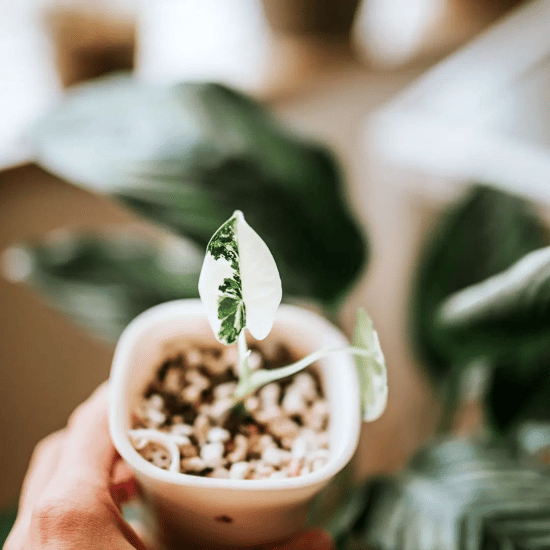
Alocasia frydek are tropical plants that grow naturally under tall trees in forest understories, they prefer bright indirect light or partial shade. Your plant shouldn’t receive more than one or two hours of direct sunlight per day, or its leaves might scorch.
If you have your plant in a room with too little light, it will grow more slowly and take a longer time to put out new leaves. The soil will take longer to dry in low light conditions as well, so take care not to overwater.
Alocasia frydek plants do well near north or east-facing windows, which receive the most morning sun and indirect light. If you have southern or western exposure, keep your plants farther back from the window, up to five feet away, to prevent them from burning in direct sunlight.
Water
While alocasia frydek likes moist soil, it doesn’t enjoy being excessively soggy or dry, so watering it on a set schedule isn’t usually the wisest course of action. The best way to tell whether your Alocasia frydek needs water is by sticking a finger into the soil. If your plant has dry soil one or two inches deep, it’s time to break out the watering can. If the soil is still moist, however, hold off on watering for a little while longer. Following this method, Alocasia frydek will likely need water two or three times a week in the spring and summer months.
Fun fact: green velvet plants have thick stems and petioles (stalks that connect leaves to stems) that store water, but they are drought intolerant.
Keep in mind that when your plant has more leaves, it requires more water to sustain them, so the soil will dry out faster. This means you’ll have to water it more often. If your plant only has a few leaves, however, take care not to overwater, since this can allow excess water to pool around the roots, causing soggy soil and root rot.
Your plant will go dormant in winter, so it will need less water during that time. Watering it once a week during its dormancy period should be sufficient.
Temperature and humidity
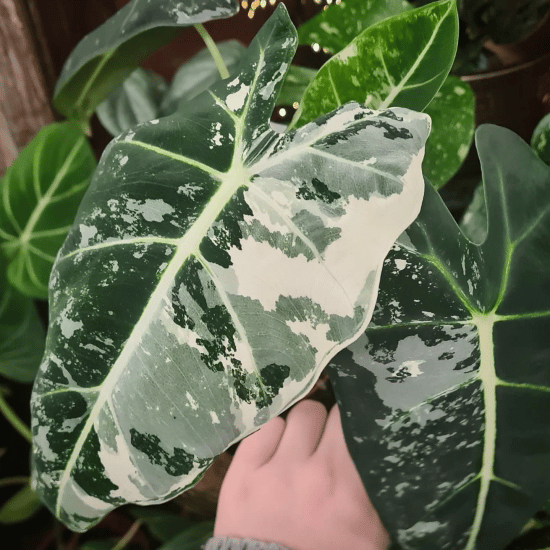
Alocasia frydek grows outdoors in USDA zones 9B through 11 and is considered a winter hardy plant. Inside, it enjoys warm temperatures between 65 degrees F and 85 degrees F. If placed in an environment with cooler temperatures that dip below 60 degrees F, your plant can go dormant, so try to keep it above this level during the growing season.
When it comes to humidity, as a tropical plant, Alocasia frydek can’t get enough. You, however, probably can. If you can maintain high humidity in your home above 50%, your plant will thrive. Depending on your area’s local humidity rates, this may or may not be possible. Strive for as close to this amount as possible. Keep in mind that the green velvet plant’s leaves can go brown if the humidity in its environment is too low. If you need to boost your Alocasia frydek’s humidity levels:
- Put it close to other plants to increase natural humidity
- Place it in the bathroom, since shower steam will raise humidity
- Put it on top of a pebble humidity tray with water, because the water will release moisture into the air
- Mist it on a regular schedule, since this will temporarily increase the amount of moisture in the air
Soil and planting
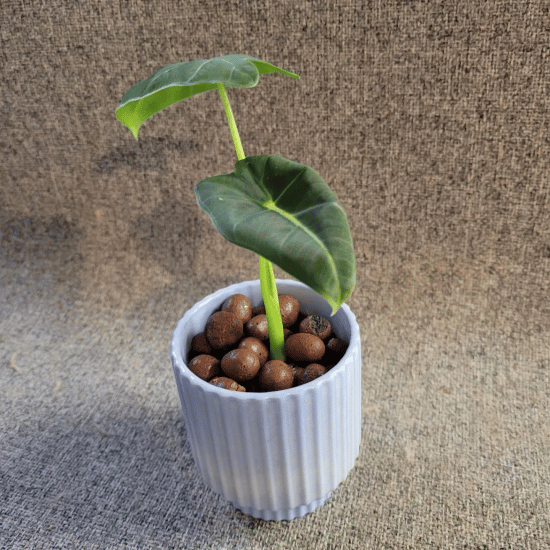
Alocasia frydek prefers an acidic soil with a pH of 5.5 to 6.5. While you can grow this plant outdoors or indoors, it needs well-draining potting mix with fertile soil to thrive. You can use a number of different materials to achieve the right mix. A combination I recommend is:
- 60% peat moss
- 30% perlite (helps drain without making soil dry)
- 10% compost (or worm castings or orchid bark)
- Add a bit of coco coir as you wish (it helps the soil retain moisture without getting soggy and is a sustainable resource)
As for repotting Alocasia frydek, this only needs to occur when it is becoming rootbound. Some signs of a plant becoming a bit root bound could include wilting, yellowing, or roots breaking through the pot, growing out of the top, or blocking its drainage holes. Your Alocasia frydek prefers smaller pots, so only increase the pot size by one or two inches when you do repot.
Fertilizer
Fertilize your Alocasia frydek to two times a month during the growing season with a balanced, water-soluble preparation like NPK 20-20-20. NPK stands for the three major micronutrients your plant needs, nitrogen (N), phosphorus (P), and potassium (K).
If it isn’t fully balanced, a fertilizer with more nitrogen and less phosphorus and potassium will work as well (the label should have a higher number for N and a lower number for P and K). Make sure it’s diluted to half-strength to avoid burning your plant.
Pruning
You can snip old yellowing or dead leaves off of your Alocasia frydek, but other than that, there is no pruning necessary.
Now that you know the ideal light, water, temperature, humidity, and soil conditions for your plant (that’s a mouthful!), let’s discuss how to propagate and our essential Alocasia frydek care tips.
Propagation guide
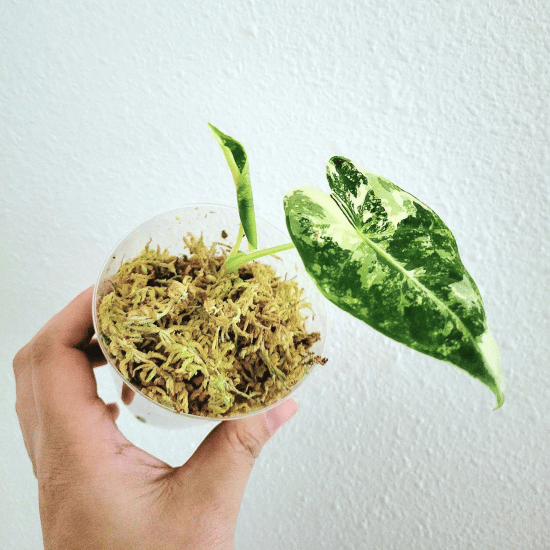
There are several ways to propagate the alocasia plant, including sphagnum moss air layering, stem cutting, division, and air layering. Which to choose?
- Sphagnum moss propagation. I recommend this method because it helps your plant grow more quickly and fully with no risk to its health. It lets stem nodes be in contact with water and air simultaneously, speeding up growth. Best of all, this method isn’t much more involved than the others.
- Stem or water propagation. Choose one of these options if your plant has at least two stems, otherwise you run the risk of losing your plant’s only stem and leaves. I would not suggest trying to propagate a baby alocasia until it has more growth.
- Division. Choose this method if you’re comfortable cutting through rhizomes and want an easy option or a new adventure.
To propagate Alocasia frydek by air layering spaghnum moss:
- Put spaghnum moss in a bowl full of water and then squeeze it to let excess water drain out.
- Wrap the moss around your plant’s stem.
- Cover the moss and stem with plastic so that they are fully enclosed. This will keep the stem moist, enabling it to grow roots in a few weeks.Tip: If the moss begins to dry out, unwrap the plastic, mist it, and then wrap it up again.
- Once the roots have grown into a large ball, cut the stem and put it in soil (either with the same plant it spawned from or another pot). You can also do this earlier when the roots are several inches long, but the larger the roots are, the more water they will absorb once potted, giving your plant a better chance to thrive.
To propagate Alocasia frydek by division:
- Carefully remove your Alocasia frydek from its pot and gently dust or use a light stream of water to remove excess soil from its roots. (Tip: The best time to do this is in spring or early summer.)
- Gently untangle the rhizome with your fingers and use a sharp, sterilized blade to divide into sections.
- Plant each division in moist potting soil.
To propagate Alocasia frydek by stem cutting in soil or water:
- Cut off a stem with sharp, sterilized shears.
- Place the stem in a jar of water (or a pot of soil, depending on your method) and put the container in a location with lots of light and heat. You should see new growth in about two weeks. If you chose the soil prop method, you’re done!
- If propagating in water, once the roots are several inches long, plant the cutting in potting mix in its own container or the same pot as the mother plant.
Now that you’re armed with a few Alocasia frydek propagation methods let’s discuss how to deal with common issues like yellowing leaves and browning leaf edges.
Common issues
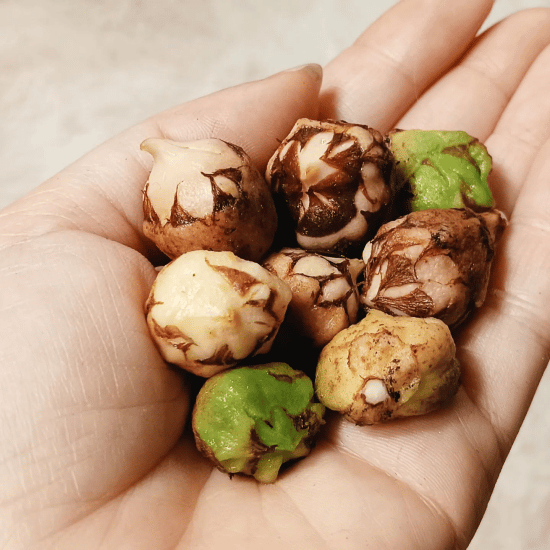
Most issues you’ll find with Alocasia frydek aren’t unique to this plant but any houseplant (especially of tropical origin) you’ll be caring for. Let’s get into the issues you might find. Don’t worry, they also have common solutions!
- Leaves yellowing or dying/drooping leaves. The air may be either too hot or cold for your plant, or you may be over or under-watering it. Check to see if it’s near any doors or windows that might let in cold drafts, or by a radiator that might let out puffs of hot air, and move it if so. Water your plant more or less frequently as needed. Keep in mind that the Alocasia frydek’s lower leaves naturally brown and yellow, shrivel up, and fall off as part of its growth process. If the plant is growing new leaves more quickly than its old ones are dying, you have nothing to worry about.
- Brown leaf tips and edges. Brown leaf edges and tips could be due to low humidity. Raise the humidity around your plant (see the “Temperature and humidity” section above) and the problem should be solved.
- Leaves falling. If this occurs during the growing season, your plant could be too cold or dry. Raise the temperature or humidity around it accordingly. If this occurs during the winter season, however, your plant may be asleep! This is a natural process that occurs during its dormant period. If you want to be sure, check the corm (bulb-like tissue at the end of its stem). If it’s mushy or rotting, chances are, your plant needs some assistance. If it’s firm, your plant is dormant. It will begin growing leaves again in the spring and summer months.
Diseases and pests
Similarly, Alocasia frydek experiences a lot of the same issues with diseases and pests as most other indoor plants. A weakened plant is usually what first leads to these secondary issues, so make sure after fixing the issue that you also make sure to restore it to a healthy environment.
Root rot, bacterial leaf spot, or crown rot. Your green velvet alocasia can be susceptible to root rot, bacterial leaf spot, or crown rot if overwatered or in soil that’s too dense. Wetness and sliminess, along with brown/gray and mushy roots, are telltale signs of rotting plant roots. Yellow leaves and brown spots can indicate other types of rot.
To prevent root rot, water your plant less frequently, and/or repot it in a mix that breathes well with adequate drainage holes.
Pests. Sapsucking pests can be attracted to the Alocasia frydek, especially spider mites. They can also entice scale, mealybugs, and aphids. Spider mites thrive in hot air like the kind your plant requires. They also like dry air, so if the air around your plant isn’t humid enough, it may attract them as well. You’ll know if your frydek has spider mites if you see webbing.
To get rid of harmful bugs, spray a mix of soapy water all over your alocasia plant, including the undersides of its leaves and stems. If this doesn’t work, use neem oil diluted with 50% water and spray once a week until they disappear. You will want to isolate your plant during this time so that bugs don’t hop over to any of your other plants.
Conclusion
Alocasia frydek is a wonderful plant that prefers warm temps and high humidity. Proper Alocasia frydek care means making sure it receives bright indirect sunlight and water when the first inch or two of soil is dry to the touch. Water it less during winter and don’t worry if it drops all of its leaves then – it’s just going dormant, which is a natural process.
Watch out for browning leaf tips and spider mites (see the “Diseases and pests” section for help with these topics). With the right conditions, your plant will be producing the stunning velvety leaves it’s known for in no time.
If you found this article helpful, send it to a friend and get them started on their own Alocasia frydek care journey!
FAQ
Are Alocasia frydek rare?
While Alocasia frydek might not be as readily available as other alocasia plants, they are no longer considered rare. You should be able to find them at a local garden center.
Is Alocasia frydek safe to touch?
Like other alocasia plants, Alocasia micholitziana frydek produces calcium oxalate crystals, which are toxic to humans and pets, so keep it away from both.
Why does my Alocasia frydek have water droplets on its leaves?
This is a natural process called guttation that happens more frequently if you a) use too much water or b) water at night. Roots still need water at nighttime, but they don’t take as much water vapor from leaves(transpiration). Extra water gets sent through special leaf cells called hydathodes to help prevent the plant from becoming waterlogged.
Guttation is usually good for the plant, since it helps the plant get the water and nutrients it needs. If you find it happening often, however, consider using less water or routinely water during daylight hours to prevent potential root rot.

